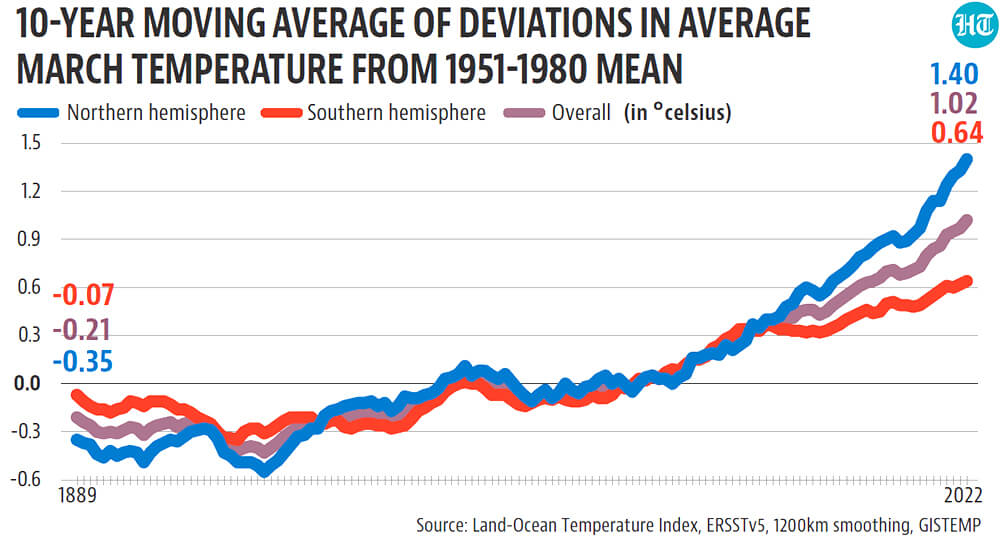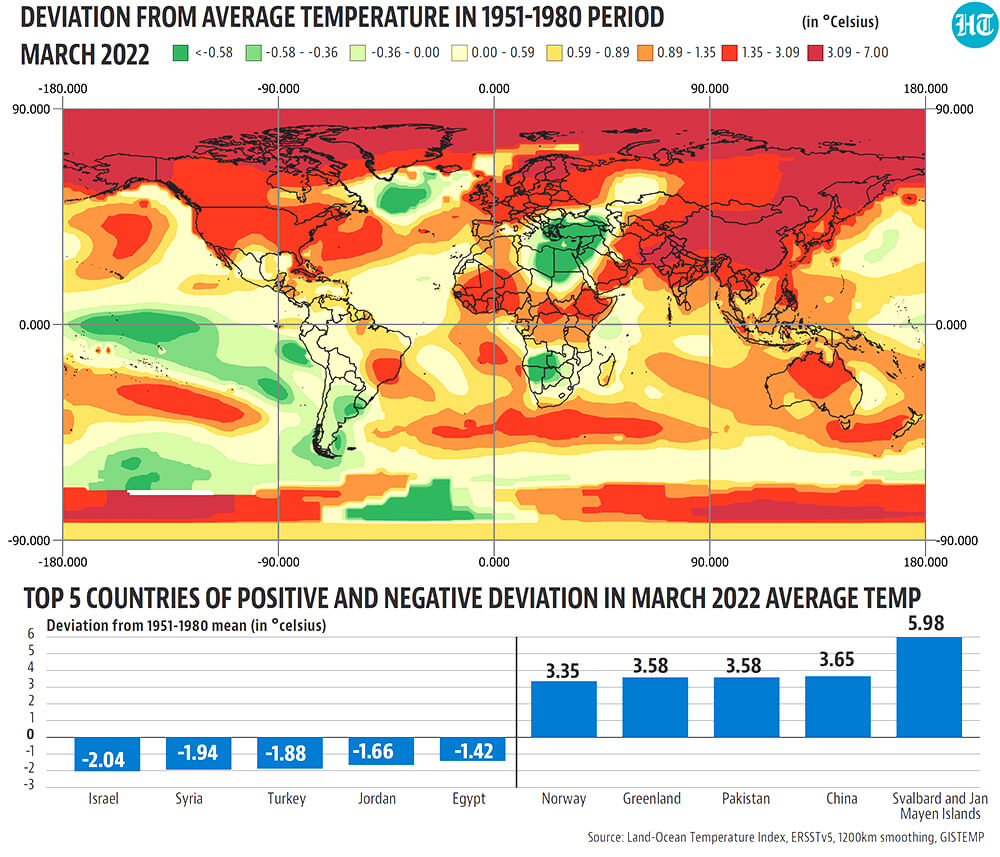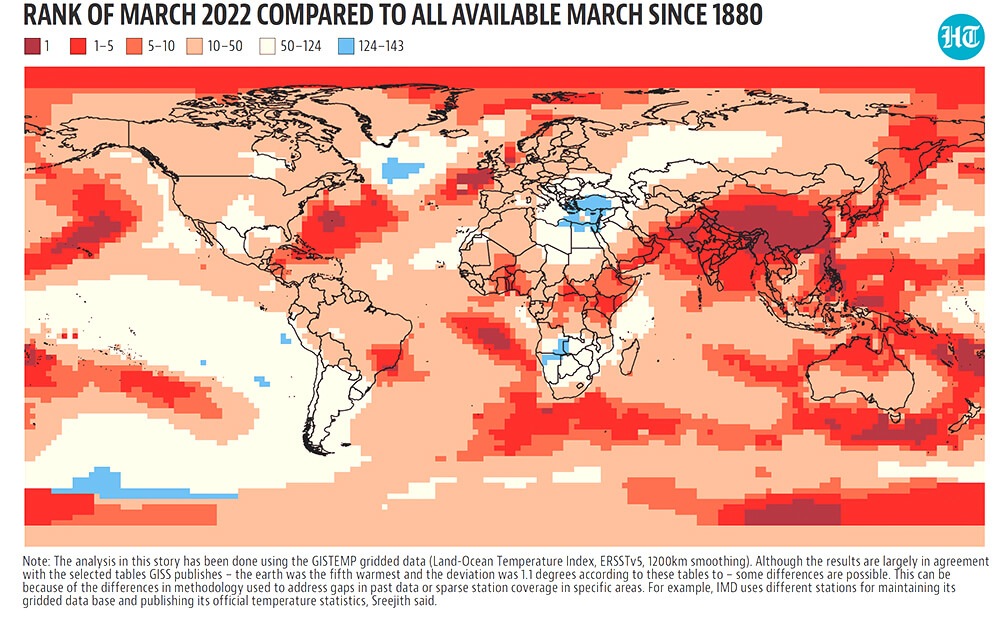Number Theory: March 2022 was oddly hot for the world, not just India
What makes this unusually warm March even more exceptional is that it followed long-term trends despite La Niña conditions. “At the global scale, the temperatures are rising regardless of the state of the tropical Pacific…,” said Gavin Schmidt, director of GISS.
March 2022 was unusually hot in India. An analysis by India Meteorological Department (IMD), Pune showed that the average temperature this March was second highest since 1901. Data released over the last week by Nasa’s Goddard Institute for Space Studies (GISS), a laboratory in the Earth Sciences division of Nasa and Berkeley Earth, a US non-profit that works with environmental data, shows that India was not alone in experiencing an unusually hot March. While a particular year being hotter or cooler than usual can be the result of specific atmospheric conditions prevailing at the time, both Nasa and Berkeley Earth said the month continued the long-term upward trend in temperatures because of human activities. Here are three charts that show how unusual this March was across the globe.

Northern hemisphere warmed more than southern hemisphere
How much hotter than usual was March 2022? The average temperature in 2022 for the planet as a whole was 1.07 degrees Celsius (°C) warmer than its mean in the 1951-1980 period (used as the normal by GISS), according to the GISTEMP gridded data, the temperature dataset developed by GISS. The deviation in the northern hemisphere was much more (1.49°C) than in the southern hemisphere (0.65°C). This is part of a long-term trend, and not surprising. Since the 1980s, the northern hemisphere has consistently shown a higher upward deviation in temperature than the southern hemisphere, a fact also verified by scientific research.

But there were some exceptional exceptions
Although the southern hemisphere did not warm as much as the northern hemisphere, a very rare heat wave affected the southernmost Antarctic continent. According to a blog post for Berkeley Earth by its lead scientist Robert Rohde, temperatures at the research station at Dome C were 38.5°C warmer than is usual for March. “Looking at past statistical distributions, we estimated that this event may have been a roughly once-in-200-year event. However, any possible link to climate change still needs to be evaluated and understood,” the post said. Northern Australia and parts in south-eastern Brazil were other areas in the southern hemisphere that showed much more variation than the southern hemisphere did on average. In the northern hemisphere, middle-eastern countries and parts of northern Pacific and Atlantic were at odds with the average deviation of the hemisphere.

Among 151 countries and territories for which this analysis is possible using the GISTEMP gridded data, Svalbard and Jan Mayen (islands in the northern Arctic Ocean), China, Pakistan, Greenland, and Norway showed the most positive deviation. The 2.38 degrees deviation seen in India was only the 24th highest positive deviation. Israel, Syria, Turkey, Jordan and Egypt experienced the most negative deviation.
Fifth warmest March since 1880
The absolute values of deviation tell us how much warmer a place was than is usual for it, which can have both short-term and long-term effects on, say, crops or the way people live. However, for some places the absolute values of deviation may not tell us how exceptional the temperature in a particular year was. Ranks can help us see that. Despite a lower deviation than the northern hemisphere, for example, the March 2022 average temperature in the southern hemisphere was the sixth highest since 1880, not any less exceptional than the northern hemisphere, which saw the fifth warmest March. The global average was also the fifth highest. Similarly, although India did not see as big a deviation as its neighbours, it experienced its own second hottest March by average temperatures. China, Bangladesh, Myanmar, Philippines, and Pakistan experienced their hottest March ever.

What makes this unusually warm March even more exceptional is that it followed long-term trends despite La Niña conditions. “At the global scale, the temperatures are rising regardless of the state of the tropical Pacific. The La Nina/El Nino events modulate things a little, but the trends are clear regardless,” said Gavin Schmidt, director of GISS. Consistent global warming and local atmospheric conditions could have both had a role to play this March, according to DS Pai, director of Institute for Climate Change Studies, Kerala, although a definitive answer will require a more thorough analysis of specific regions. For example, he cited the lack of western disturbances, clear skies, and north-westerly winds bringing warm air for the warmer than usual March in India. O P Sreejith, head of the Climate Monitoring and Prediction Group at IMD Pune echoed these views.
Note: The analysis in this story has been done using the GISTEMP gridded data (Land-Ocean Temperature Index, ERSSTv5, 1,200km smoothing). Although the results are largely in agreement with the selected tables GISS publishes – the earth was the fifth warmest and the deviation was 1.1 degrees according to these tables to – some differences are possible. This can be because of the differences in methodology used to address gaps in past data or sparse station coverage in specific areas. For example, IMD uses different stations for maintaining its gridded data base and publishing its official temperature statistics, Sreejith said.
Get Current Updates on India News, Lok Sabha election 2024 live, Election 2024 along with Latest News and Top Headlines from India and around the world.






